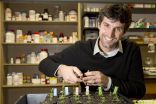(Press-News.org) A national coalition of experts that includes two University of Washington researchers has a bold plan to reduce behavioral health problems such as violence and depression among young people across the country by 20 percent in a decade.
And their proposal rests on one simple principle: prevention.
The group's paper, recently published on the National Academy of Medicine website, recommends implementing evidence-based prevention programs on a national scale to reduce a host of problems ranging from drinking to delinquent behavior, anxiety and risky driving. It notes that treatment, lost productivity and crime related to behavioral health problems among young people cost an estimated $247 billion a year.
Lead author David Hawkins, founding director of the Social Development Research Group, an organization within the UW School of Social Work, said the typical approach to addressing behavioral health problems among young people has been to step in only after they take hold.
"So much of what we do is to wait until there are big problems, then we start intervening," he said. "As consumers of programs that are costing public money, we need to ask, 'What's the scientific evidence that this works?'"
Hawkins has seen that evidence firsthand. Communities That Care, the community-level prevention system developed by Hawkins and Social Development Research Group co-founder Richard Catalano, a co-author on the paper, has been shown to cut smoking and alcohol use among young people by more than 30 percent, and overall juvenile crime by 25 percent. The paper highlights other prevention initiatives that have helped prevent sexual behavior, self-injury, anxiety, unwanted pregnancy, violence and other youth problems.
The paper sets two overarching goals: to cut behavioral health problems among young people by 20 percent in the next decade, and also reduce the disproportionately higher rates of those problems among disadvantaged youth by the same amount. It lays out seven steps for achieving those targets, ranging from investing 10 percent of all public funds spent on young people in effective prevention programs to creating strategies to develop a new cadre of prevention workers.
The coalition, which has more than 60 members from a range of disciplines, has started forming committees to address the seven goals. One group, for example, is putting together curricula to train prevention workers, while another is working with state leaders to develop systems to promote and implement effective prevention programs.
Hawkins acknowledges that the success of the effort will rely on buy-in from states and organizations across the country. He hopes the initiative can garner endorsement from a few high-profile leaders, and ideally, a foundation or corporation that could help cover implementation costs.
"What we're trying to do is build interest and enthusiasm," he said. "We're saying, 'Look, we need to work together across disciplines and organizations to really take these things to scale."
The paper's 19 authors include experts from some of the nation's leading social work, medical and research institutions. Their proposal is part of the inaugural Grand Challenges for Social Work Initiative, a project by the American Academy of Social Work & Social Welfare that aims to engage practitioners in coming up with "ambitious yet achievable" goals for addressing social issues. The 12 preliminary proposals selected by the academy focus on topics including ending racial injustice, reducing mass incarceration and stopping family violence.
The roots of the coalition's paper can be traced back to 1980, when one of Hawkins' UW social work colleagues decided to see how many randomized experiments there had been in the U.S. aimed at preventing delinquent behavior. There were just nine, he discovered, and none had proven that delinquency could be curbed. Back then, Hawkins said, efforts to address problem behaviors in young people primarily involved "people sitting around a table" thinking about what might work, then doing it.
"There was no evidence that you could prevent delinquency in America before kids get involved with the justice system," he said.
That began to change in the 1980s and '90s, Catalano said, as prevention science emerged along with an increase in randomized, controlled trials of prevention programs. An online registry run by the University of Colorado Boulder now lists more than 50 evidence-based youth development programs aimed at promoting positive behaviors and discouraging negatives ones, and the Obama administration has invested in programs focused on preventing teen pregnancy and providing home visits for first-time, high-risk mothers.
Organizations have started commercializing effective interventions and making them more available to providers, Catalano said, and a focus on evidence-based programs is increasing at various levels of government and in philanthropy.
"The market is starting to grow up," he said. "The purveyor organizations are coming online, and federal and state agencies are starting to say, 'We want evidence-based programs.'"
There has been progress in reducing problems such as teen pregnancy and youth violence, Hawkins said, but in other areas such as infant mortality, children living in poverty and mental disorders among young people, the U.S. lags behind other countries. Proven prevention programs are the most effective way to improve those statistics, Hawkins said.
"I don't think the general public really knows we have this knowledge that would allow us to say we could reduce rates of these problems by 20 percent in a 10-year period of time," he said. "That's a pretty bold statement."
INFORMATION:
For more information, contact Hawkins at jdh@uw.edu or 206-543-7655 or Catalano at catalano@uw.edu or 206-543-6382.
Many physicians are pushing back against or debating new requirements for maintaining medical board certifications, which affect more than 250,000 physicians nationwide. Now, a new study by UC San Francisco and Stanford University researchers concludes that the cost of implementing the most recent requirements will be an estimated $5.7 billion over the next 10 years.
In their study, published online on July 27, 2015, in the Annals of Internal Medicine, the researchers found that most costs of the latest maintenance-of-certification (MOC) requirements implemented for ...
Athens, Ga. - An international team of researchers led by scientists at the University of Georgia has discovered how parasitic plants, which steal their nutrients from another living plant, evolved the ability to detect and attack their hosts. Their findings, published recently in the journal Science, could lead to new techniques to control the thieving weeds.
There are thousands of parasitic plant species, but the most burdensome for humans are those that infiltrate farmland and destroy crops. Parasite infestations reduce crop yields by billions of dollars each year, ...
In cells with latent HIV infection, the virus is dormant, and such cells are therefore not attacked by the immune system or by standard antiretroviral therapy. To eradicate the virus from the human body and truly cure a patient, reservoirs of latently infected cells need to be activated and eliminated "the so-called "kick-and-kill" approach. Two studies published on July 30th in PLOS Pathogens report encouraging results on the use of a combination of several drugs to efficiently reactivate HIV in cells with latent infection.
Please contact plospathogens@plos.org if you ...
A deadly fungus identified in 2013 could devastate native salamander populations in North America unless U.S. officials make an immediate effort to halt salamander importation, according to an urgent new report published today in the journal Science.
San Francisco State University biologist Vance Vredenburg, his graduate student Tiffany Yap and their colleagues at the University of California, Berkeley and the University of California, Los Angeles say the southeastern United States (particularly the southern extent of the Appalachian Mountain range and its southern neighboring ...
Scientists at Columbia University's Mailman School of Public Health and the School of Public Health of Li Ka Shing Faculty of Medicine at the University of Hong Kong have shown for the first time that it is possible to predict the timing and intensity of influenza outbreaks in subtropical climates like Hong Kong where flu seasons can occur at different times and more than once during a year. Results appear online in the journal PLOS Computational Biology.
Since the 2013-2014 season, the Mailman School scientists have published weekly regional flu forecasts for over 100 ...
Worldwide, influenza kills an estimated 250,000 to 500,000 people each year. A new study publishing in PLOS Computational Biology has shown that for the first time it is possible to predict the timing and intensity of influenza outbreaks in subtropical climates, such as Hong Kong, where flu seasons can occur at irregular intervals year-round.
The team of scientists from Columbia University's Mailman School of Public Health and the University of Hong Kong used data from a network of 50 outpatient clinics and laboratory reports in Hong Kong from 1998 to 2013 as a test case ...
This news release is available in Japanese.
During the first ever landing of a probe on a comet, the world held its breath as Philae survived a bouncy landing on comet 67P/Churyumov-Gerasimenko on November 12, 2014. This special issue of Science highlights seven new studies that delve further into the data that has been transmitted back by Philae. In a detailed account, Jens Biele et al. describe the critical moments where Philae descends on 67P, only to bounce off the soft, intended landing area and finally settle on a harder surface farther away. Analysis ...
This news release is available in Japanese.
By studying how water striders jump on water, Je-Sung Koh and colleagues have created a robot that can successfully launch itself from the surface of water. As the team watched the water strider jump on water surfaces using high-speed cameras, they noticed that the long legs accelerate gradually, so that the water surface doesn't retreat too quickly and lose contact with the legs. Using a theoretical model of a flexible cylinder floating on liquid, the authors found that the maximum force of the water striders' legs is always ...
This news release is available in Japanese.
The international pet trade threatens to spread a deadly fungal infection to North America's rich wild salamander population and must be frozen, according to the authors of this Policy Forum. Batrachochytrium salamandrivorans (Bsal) is a highly virulent, often fatal fungus that infects salamanders, and there is no effective way to control it after it infects a wild population, say Tiffany Yap and colleagues. It is theorized that Bsal started in Asia and spread to wild European salamanders via the international pet ...
SAN FRANCISCO, CA - July 30, 2015 - A study released today at the Society of NeuroInterventional Surgery 12th Annual Meeting in San Francisco, California, indicates that strict adherence to two commonly-used tools to weigh the risk of treating unruptured aneurysms may not prevent the majority of morbidity-mortality outcomes associated with ruptured intracranial aneurysms. Thus, the International Study of Unruptured Intracranial Aneurysms (ISUIA) criteria and the PHASES score require additional research to determine their effectiveness.
Published in 2003, the ISUIA study ...




